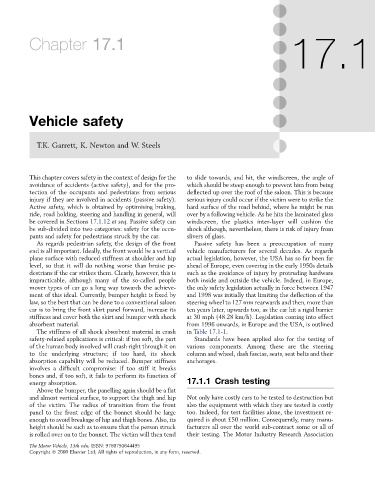Page 558 - Automotive Engineering Powertrain Chassis System and Vehicle Body
P. 558
17.1
Chapter 17.1
Vehicle safety
T.K. Garrett, K. Newton and W. Steels
This chapter covers safety in the context of design for the to slide towards, and hit, the windscreen, the angle of
avoidance of accidents (active safety), and for the pro- which should be steep enough to prevent him from being
tection of the occupants and pedestrians from serious deflected up over the roof of the saloon. This is because
injury if they are involved in accidents (passive safety). serious injury could occur if the victim were to strike the
Active safety, which is obtained by optimising braking, hard surface of the road behind, where he might be run
ride, road holding, steering and handling in general, will over by a following vehicle. As he hits the laminated glass
be covered in Sections 17.1.12 et seq. Passive safety can windscreen, the plastics inter-layer will cushion the
be sub-divided into two categories: safety for the occu- shock although, nevertheless, there is risk of injury from
pants and safety for pedestrians struck by the car. slivers of glass.
As regards pedestrian safety, the design of the front Passive safety has been a preoccupation of many
end is all important. Ideally, the front would be a vertical vehicle manufacturers for several decades. As regards
plane surface with reduced stiffness at shoulder and hip actual legislation, however, the USA has so far been far
level, so that it will do nothing worse than bruise pe- ahead of Europe, even covering in the early 1950s details
destrians if the car strikes them. Clearly, however, this is such as the avoidance of injury by protruding hardware
impracticable, although many of the so-called people both inside and outside the vehicle. Indeed, in Europe,
mover types of car go a long way towards the achieve- the only safety legislation actually in force between 1947
ment of this ideal. Currently, bumper height is fixed by and 1998 was initially that limiting the deflection of the
law, so the best that can be done to a conventional saloon steering wheel to 127 mm rearwards and then, more than
car is to bring the front skirt panel forward, increase its ten years later, upwards too, as the car hit a rigid barrier
stiffness and cover both the skirt and bumper with shock at 30 mph (48.28 km/h). Legislation coming into effect
absorbent material. from 1996 onwards, in Europe and the USA, is outlined
The stiffness of all shock absorbent material in crash in Table 17.1-1.
safety-related applications is critical: if too soft, the part Standards have been applied also for the testing of
of the human body involved will crash right through it on various components. Among these are the steering
to the underlying structure; if too hard, its shock column and wheel, dash fascias, seats, seat belts and their
absorption capability will be reduced. Bumper stiffness anchorages.
involves a difficult compromise: if too stiff it breaks
bones and, if too soft, it fails to perform its function of
energy absorption. 17.1.1 Crash testing
Above the bumper, the panelling again should be a flat
and almost vertical surface, to support the thigh and hip Not only have costly cars to be tested to destruction but
of the victim. The radius of transition from the front also the equipment with which they are tested is costly
panel to the front edge of the bonnet should be large too. Indeed, for test facilities alone, the investment re-
enough to avoid breakage of hip and thigh bones. Also, its quired is about £50 million. Consequently, many manu-
height should be such as to ensure that the person struck facturers all over the world sub-contract some or all of
is rolled over on to the bonnet. The victim will then tend their testing. The Motor Industry Research Association
The Motor Vehicle, 13th edn; ISBN: 9780750644495
Copyright Ó 2000 Elsevier Ltd; All rights of reproduction, in any form, reserved.

